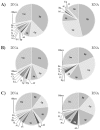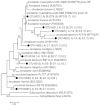Novel microbiological and spatial statistical methods to improve strength of epidemiological evidence in a community-wide waterborne outbreak
- PMID: 25147923
- PMCID: PMC4141750
- DOI: 10.1371/journal.pone.0104713
Novel microbiological and spatial statistical methods to improve strength of epidemiological evidence in a community-wide waterborne outbreak
Abstract
Failures in the drinking water distribution system cause gastrointestinal outbreaks with multiple pathogens. A water distribution pipe breakage caused a community-wide waterborne outbreak in Vuorela, Finland, July 2012. We investigated this outbreak with advanced epidemiological and microbiological methods. A total of 473/2931 inhabitants (16%) responded to a web-based questionnaire. Water and patient samples were subjected to analysis of multiple microbial targets, molecular typing and microbial community analysis. Spatial analysis on the water distribution network was done and we applied a spatial logistic regression model. The course of the illness was mild. Drinking untreated tap water from the defined outbreak area was significantly associated with illness (RR 5.6, 95% CI 1.9-16.4) increasing in a dose response manner. The closer a person lived to the water distribution breakage point, the higher the risk of becoming ill. Sapovirus, enterovirus, single Campylobacter jejuni and EHEC O157:H7 findings as well as virulence genes for EPEC, EAEC and EHEC pathogroups were detected by molecular or culture methods from the faecal samples of the patients. EPEC, EAEC and EHEC virulence genes and faecal indicator bacteria were also detected in water samples. Microbial community sequencing of contaminated tap water revealed abundance of Arcobacter species. The polyphasic approach improved the understanding of the source of the infections, and aided to define the extent and magnitude of this outbreak.
Conflict of interest statement
Figures




Similar articles
-
Two Drinking Water Outbreaks Caused by Wastewater Intrusion Including Sapovirus in Finland.Int J Environ Res Public Health. 2019 Nov 9;16(22):4376. doi: 10.3390/ijerph16224376. Int J Environ Res Public Health. 2019. PMID: 31717479 Free PMC article.
-
A large community outbreak of gastroenteritis associated with consumption of drinking water contaminated by river water, Belgium, 2010.Epidemiol Infect. 2015 Mar;143(4):711-9. doi: 10.1017/S0950268814001629. Epub 2014 Jul 25. Epidemiol Infect. 2015. PMID: 25062494 Free PMC article.
-
Epidemiological and serological investigation of a waterborne Campylobacter jejuni outbreak in a Danish town.Epidemiol Infect. 2017 Mar;145(4):701-709. doi: 10.1017/S0950268816002788. Epub 2016 Dec 1. Epidemiol Infect. 2017. PMID: 27903324 Free PMC article.
-
Microbial agents associated with waterborne diseases.Crit Rev Microbiol. 2002;28(4):371-409. doi: 10.1080/1040-840291046768. Crit Rev Microbiol. 2002. PMID: 12546197 Review.
-
Campylobacteriosis Outbreak Linked to Municipal Water, Nebraska, USA, 20211.Emerg Infect Dis. 2024 Oct;30(10):1998-2005. doi: 10.3201/eid3010.231509. Emerg Infect Dis. 2024. PMID: 39320141 Free PMC article. Review.
Cited by
-
Isolation and identification of Arcobacter species from environmental and drinking water samples.Folia Microbiol (Praha). 2016 Nov;61(6):479-484. doi: 10.1007/s12223-016-0460-0. Epub 2016 Apr 22. Folia Microbiol (Praha). 2016. PMID: 27106697
-
Development of a Quantitative PCR Assay for Arcobacter spp. and its Application to Environmental Water Samples.Microbes Environ. 2018 Sep 29;33(3):309-316. doi: 10.1264/jsme2.ME18052. Epub 2018 Sep 6. Microbes Environ. 2018. PMID: 30185726 Free PMC article.
-
The Persistence of Bacterial Pathogens in Surface Water and Its Impact on Global Food Safety.Pathogens. 2021 Oct 27;10(11):1391. doi: 10.3390/pathogens10111391. Pathogens. 2021. PMID: 34832547 Free PMC article. Review.
-
Human enteroviruses associated with and without diarrhea in Thailand between 2010 and 2016.PLoS One. 2017 Jul 27;12(7):e0182078. doi: 10.1371/journal.pone.0182078. eCollection 2017. PLoS One. 2017. PMID: 28750058 Free PMC article.
-
Isolation and Virulence Gene Profiling of Arcobacter spp. from Seafood and Its Environment.Curr Microbiol. 2025 Apr 20;82(6):254. doi: 10.1007/s00284-025-04220-2. Curr Microbiol. 2025. PMID: 40253654
References
-
- Laine J, Huovinen E, Virtanen MJ, Snellman M, Lumio J, et al. (2011) An extensive gastroenteritis outbreak after drinking-water contamination by sewage effluent, Finland. Epidemiol Infect 1–9. - PubMed
MeSH terms
Substances
Associated data
- Actions
- Actions
LinkOut - more resources
Full Text Sources
Other Literature Sources
Medical
Molecular Biology Databases
Miscellaneous

